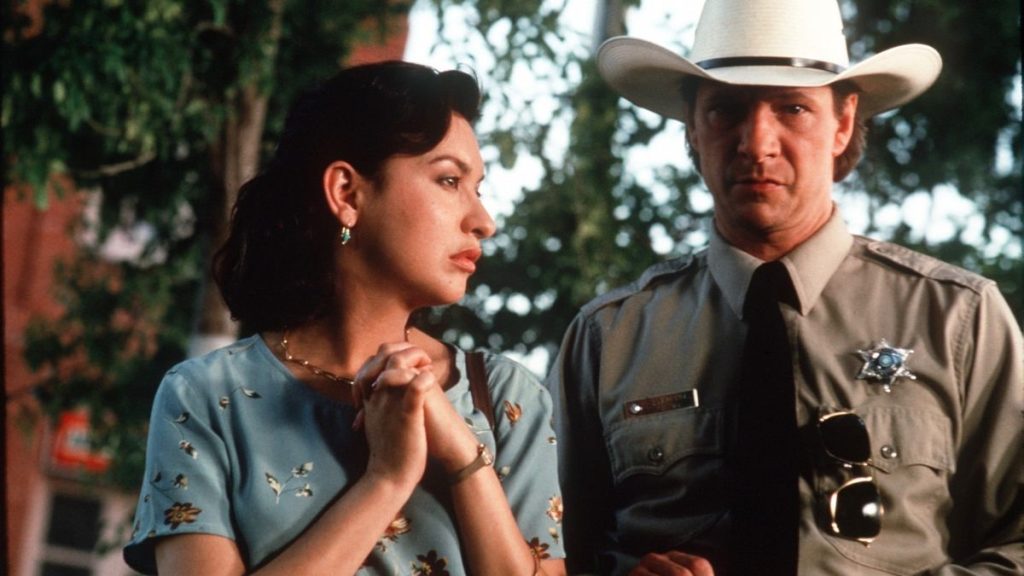John Sayles’s masterful 1996 drama Lone Star is the type of multi-generational saga about family, community, race, love, murder, politics, and power that we usually find in the pages of novels—particularly the kind dubbed ‘The Great American Novel’. There’s no real cinematic equivalent to this nebulous, oft-derided concept—The Great American Motion Picture—although if we were to nominate candidates, I’d argue that Lone Star has as much stake to the claim as any of your bigger, more obvious titles.
From his early days as a screenwriter for Roger Coman through his illustrious career as the patron saint of post-70’s independent cinema, Sayles has always been interested in stories specifically about the American experience and Lone Star—part neo-noir, part neo-western, 100% Saylesian ensemble drama—may just be his ultimate statement on the subject. In fact, Lone Star feels more relevant today than ever before. Fitting, then, that it should receive a second life some 28 years after its initial release, courtesy of a brand new 4K restoration and Criterion Collection Blu-ray treatment.
Lone Star begins with the excavation of one secret and ends with the burial of another. In between, Sayles lays out a riveting mystery that spans 40 years. In the Texas border town of Frontera, the skeleton of corrupt, sadistic ex-sheriff Charlie Wade (Kris Kristofferson) is discovered half-buried along a stretch of desert. Current sheriff Sam Deeds (Chris Cooper), reluctantly following in the footsteps of his late father, (and town hero) Sheriff Buddy Deeds (Mathew McConaughey), decides to investigate, even as he suspects (and half-hopes) that his old man will prove the guilty party.
As with every Sayles picture, starting with 1979’s Return of the Secaucus 7, this plot is merely the coat rack upon which he hangs his true interest: people. Lone Star is populated by almost a dozen intersecting characters. Some of them,including Sam’s former high school flame Pilar (Elizabeth Pena), now a widowed high school teacher; her wealthy, restaurateur mother Mercedez (Míriam Colón); former Frontera deputy-turned-mayor Hollis Pogue (Clifton James); and Black/Native bar owner and unofficial “mayor of Darktown” Otis (Ron Canada), are personally linked to the central crime, but others are not.
Sub-and-side plots revolve around several members of the local army base, including Otis’s estranged son Delmmore (Joe Morton), now a Colonel; undocumented members of Mercedez’s kitchen staff; and, in one show-stopper of a scene, Sam’s mentally-unstable, football-obsessed ex-wife (Frances McDormand). Rather than detract from the main story, these various threads help fill out the world of Lone Star, giving it a tangible depth and sense of verisimilitude. One of the things that makes Sayles’s work so singular (along with his specific brand of dialog—clever and literary without ever coming off as stylized) is the sense that even after the credits roll, the lives within continue on. You wouldn’t categorize Sayles’s style as realism or neorealism, yet what you take from them—even at their most dramatically heightened—is a sense of reality.
During a recent post-screening Q&A of Lone Star at Hollywood’s Egyptian Theater, Sayles described his outlining process, which he cribbed from classic Hollywood director Allan Dwan (best known for his work in the Western genre): he will make a chart of all of his main characters and draw lines between them to see who intersects with who. Those who only cross paths with one other character, he’ll excise from the script. In this way, he’s able to leave hardly anything on the cutting room floor during editing (which he undertakes himself), a truly impressive feat considering how sprawling his films can be.
In the case of Lone Star, this sense of sprawl never detracts from the core mystery, which resolves in a logical, but entirely satisfying way. I don’t want to give away more, but the answer to the question of who killed Charlie Wade isn’t even the main surprise Lone Star holds in store. In a lesser filmmaker’s hands, the late-act turn it takes could play as ridiculous or even insane, but Sayles manages to imbue it with a devastating yet redemptive allegorical force.
Yet, it would be wrong to look at Lone Star entirely as allegory, especially since it directly addresses several key political issues—issues which, in the late ‘90s, were more localized, but which today are part of the national discourse. Characters in Lone Star argue, ponder and pontificate over illegal immigration, changing racial demographics (“white genocide” in today’s idiotic parlance), and, in a scene that feels straight out of a 2024, new school text books that give a more holistic and accurate account of the Texas history (in other words: Critical Race Theory).
It’s tempting to credit Lone Star as ahead of its time, but the fact is that the openly progressive Sayles has always been an artist specifically of his time. He was paying attention to these issues when few, if any, of his peers couldn’t be bothered. Only now that they’ve overwhelmed the culture at large are other filmmakers addressing them. But those who’ve followed Sayles’s career over the decades know he was there first.
But what’s especially compelling about Lone Star is that, while Sayles’s sympathies clearly lie with the Tejano and Native activists who wish to expose the ugly, bloody truth of America’s history, it ultimately comes to the conclusion that for people to live their best lives, they have to move past it. The past may not want to stay buried, but it’s up to us to let it stay in the past where it belongs.
Or, as the late, great Elizabeth Pena puts it in the film’s most memorable line: “Forget the Alamo.”
“Lone Star” is out Tuesday on Blu-ray and 4K UHD.

